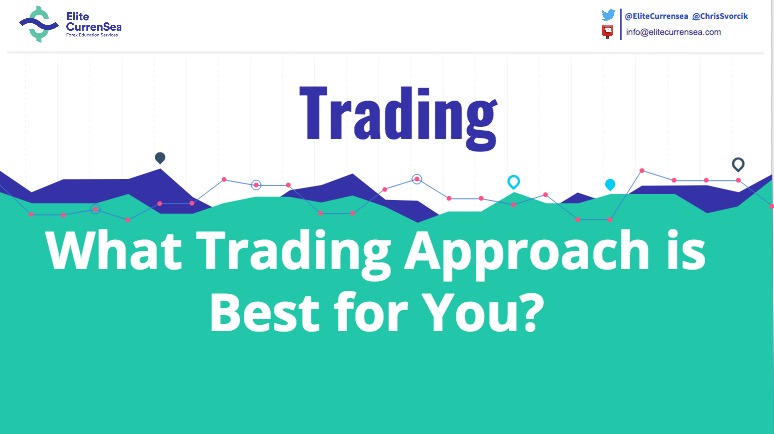What Trading Approach is Best for You?

Dear Traders,
the financial trading industry is full of people and businesses that are trying to offer “the best way” to trade.
This can be very confusing as we try to find our own way through the great maze of trading.
Today’s article will cover the pros and cons of various trading approaches and how you can evaluate which one may be best suited to you.
Types of Trading Approaches
For the sake of this article, I will simplify trading approaches into 3 broad categories:
Intra-day trading/Scalping
Intra-week swing Trading
Medium to long-term positioning
There are many different ‘strategies’ and systems that are used in each of these categories, which I will not discuss in this article. Instead the focus will be on the trading approaches because once you are clear about what each of them involves in terms of work load and psychology, you will find it easier to choose or develop you own system that is most suited to you as an individual.
Evaluating Who You Are and Your Needs
Each trading approach presents different types of psychological challenges. It is therefore very useful to assess your own psychological strengths and weaknesses, so that you know better under which work conditions you thrive the most.
Knowing who you are, and what you need in order to function at optimum, will be a huge step towards making you a successful trader.
You will most likely find that you will favor an approach that plays into your strengths and avoids as many of your weak spots as possible.
Having said that, there are certain mental challenges that will be encountered during trading, no matter what approach you choose. So you have to be prepared for facing some of your inner demons in any case (check out my previous articles on Trading psychology for more details on this).
So let’s dissect these 3 trading approaches in more detail…
Intra-Day Scalping
(ecs.CAMMACD system fit’s into this trading approach)
This approach involves frequently entering trades that conclude very quickly, usually within some hours or even minutes.
It requires very close monitoring of open positions and making quick decisions, as well as a lot of on-going scanning for trade setups during the main trading hours of the day. This approach generally means taking many small amounts of profit rather than expecting large reward-to-risk ratio wins.
While this approach may sound appealing due to the quick resolution of trades, there is more to it and may not be suited to everyone.
Here are some key points to consider for Intra-day Trading/Scalping:
- Do you have enough spare time to analyse and manage trades during the required hours of the day (i.e. usually London session and/or NY session)
- Are you happy with management-intensive work, where your full attention is required while you have open positions?
- Are you able to keep a cool head and stick to your chosen trading rules, while being under significant time pressure
- Are you able to be satisfied with small profits per trade that may add up to something more substantial over some time
Intra-Week Swings
(ecs.SWAT system falls mainly into this trading approach)
This approach engages in somewhat bigger price swings and takes place on medium time frames, such as the 1 hour or 4 hour charts. It requires less intense open trade management because one is dealing with broader swings that allow for more up-and-down price flows. However it still requires scanning many charts on an ongoing daily rhythm to find suitable new trade setups.
Here are some key points to consider for Intra-Week Swing Trading:
- Are you able to juggle and evaluate multiple setup developments? Swing trading can mean a certain degree of multi-tasking, keeping an eye on several setups developments at once and being able to choose between them.
- Are you able to cope with watching your open trades go into minus for (sometimes) considerable amount of time without panicking, while the swing works itself out (this will happen more often with swing trading compared to short-term scalping, which either go right or stop out quickly)
- Equally, can you cope with seeing potential open-trade profits grow and shrink several times, while a trade works its way to its intended target, or will you feel too anxious and interfere prematurely?
- Do you have patience to wait for good setups to appear and be happy not to have new trades come about for numerous days?
Medium to Long-Term Positioning
Trade systems within this approach analyse larger market structures with the aim to have positions open for multiple weeks, months or even years. Naturally, this approach comes with its own unique challenges. The analysis process tends focus very intensely on a chart of interest rather than spread out across many instruments. Virtually all of the effort goes into pre-trade analysis which can go on for weeks. Setups are being monitored for readiness over a longer periods, which means that it gives you the most flexibility in terms of your work time, e.g. you can do an hour of analysis for a setup, and come back to it a day or two later and continue because the actual trade entry may not be ready for some time. Management after trade entry is very minimal because most of the energy has gone into thorough pre-analysis and one is expecting price to move in one direction over a longer period of time. The main job during successful open trades is to evaluate opportune ‘scale-in’ points, where new positions are added to the original one. So the least amount of setups are entered with this approach, but it is compensated for by adding more positions to the same setup.
Here are some key points to consider for Medium to Long Term Positioning:
- Do you prefer to be well-organised and planned out in advance, without the pressure of making decision within a short period of time?
- Do you have a certain kind of fastidious mindset that likes going into in-depth analysis and planning before taking action?
- Are you patient and happy to wait for the best setups, sometimes for many weeks?
- Are you able to cope with large fluctuations in your floating profit/loss, while open trades work through many degrees of swings towards your intended target?
- Do you prefer to deal with one thing at a time rather than multi-tasking?
Conclusion
The saying ‘Many roads lead to Rome’ certainly is true when it comes to trading approaches and systems. The key lies in finding a road that is comfortable and suitable to you. A trading approach and system must fit you individually, like a well-tailored garment. Find an approach that plays into your strengths and avoids your weak areas.
All the best along your trading journey
Hubert
.







Leave a Reply